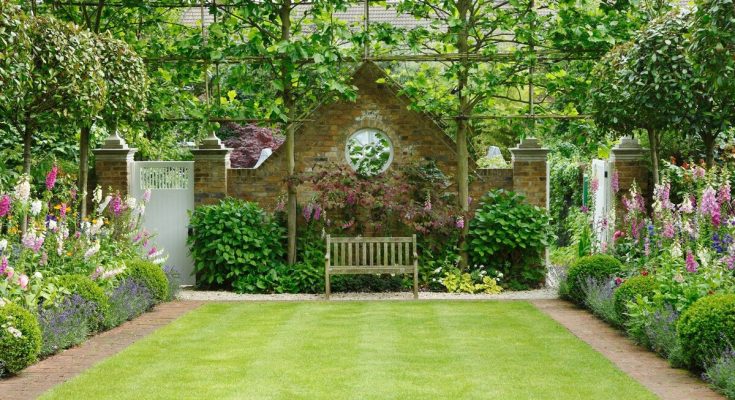Do you want to create a beautiful garden? No matter how small your space, there are design principles you can apply to beautify your balcony, porch or yard.

Beautiful gardens appeal to our senses. The colours and immense diversity of design combinations, fragrance, flavours, sounds from birds and insects attracted to the plants and variety of textures.
Go for a drive around your neighbourhood and take notice of the gardens that catch your eye or next time you visit a friend’s garden, be observant and tune in to what you love about it. No doubt they will be applying some design principles and elements that apply whether they are used in art, graphics, building, interior or garden design.
Simple concepts can make a HUGE difference to the enjoyment of your garden space and particularly so, when it is a micro garden. Designers use these principles all over the world to make spaces really stand out and visually beautiful. Less really can be more if you know how.

10 Tips for Beautiful Gardens in Small Spaces
1. Add flowers or flowering plants
Splashes of colour break up green, provide variety, contrast and focal points. Try sowing both annuals and perennial flowers. e.g. cosmos, hydrangeas, sunflowers and marigolds.
You don’t specifically have to plant flowers though. A wide range of herbs and vegetables have beautiful flowers too. These include: chives (purple), spring onions (white), dill (yellow), thyme (pale pink to purple), basils (white or purple), pineapple sage (red), rosemary (purple), rocket (white), as well as all flowering vegetables and fruits.

Edible purple common chive flowers make a pretty splash of colour in any pot or garden bed
Beneficial insects will also be attracted to your garden and they will happily pollinate and clean up any pests for you. Flowers are a ‘win-win’ in any garden.

Pansies and perennials planted in a pot look beautiful when using repeated colours and textures
Flowers have an amazing ability to beautify any space – just pick your favourite colour theme.
“Flowers are the beautiful hieroglyphics of nature with which she indicates how much she loves us.” – Goethe
2. Control weeds
Remove weeds before they go to seed. Compost plants that compete with what you really want in your garden. Why waste money by sharing your plant food and nutrients with freeloaders? Adding an attractive and practical mulch will deter weeds from setting seed.
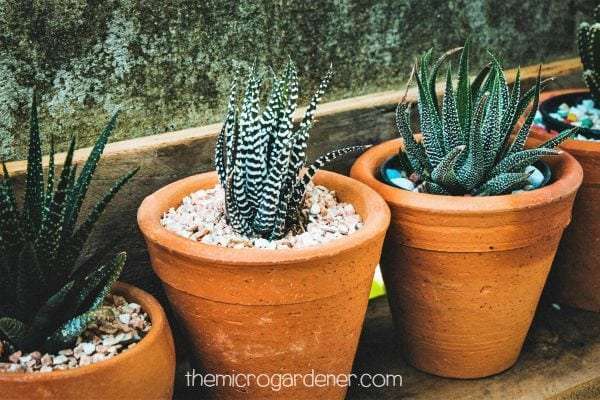
You can also use decorative mulches like white gravel or pebbles to unify pots while preventing weeds
3. Group plants around a theme
Create a collection of plants with the same foliage or flower colour for greater impact. Theming an area of your garden by clever use of colour is an easy trick to use. Stand back and take a look at the colours in your garden now. Could you move them around for better effect?
For example, putting a punnet of four or six of the same coloured flower in a container for mass planting has a greater effect than just adding one flower.

A repurposed blue bath tub planter with repeated flowers around a dwarf tree create an eye catching display
Surrounding these with another contrasting colour will ‘frame’ the picture.
This simple principle adds balance and uses another design trick – repetition.
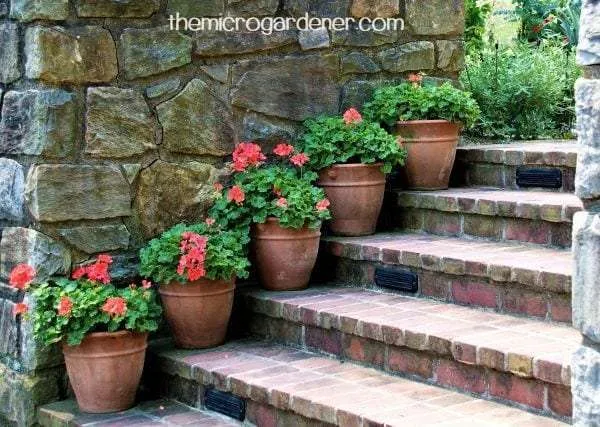
Mass planted red geraniums in pots create a focal point up steps against a stone wall
You can also achieve this simple technique by planting along the edge of a garden bed with a border plant. Or highlight the shape and colour of the container with repeated plantings. White, silver or grey and blue work well when they are teamed up with most other colours.

Here red geranium teams up with cascading Dichondra Silver Falls and silver Cineraria in beautiful blue pots
4. Add some garden art
Garden art can be any ornament, collection, treasured find or something you make. When you add decorative items to your garden, it reflects your personality and adds character to your small space.
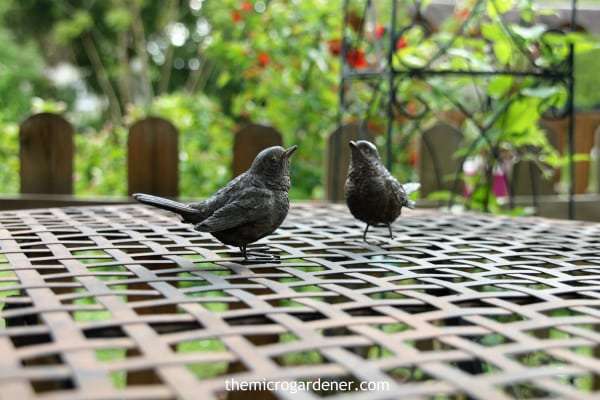
Add a touch of whimsy with something simple like these bird ornaments on an outdoor table
Stand back and see what the space needs. Perhaps a pot could be jazzed up with a small ornament.
Do you have a bare wall that you need to hide? Are you renting and you can’t paint the external walls? If so, try hanging a bamboo blind as a backdrop to your plants. Or staple some fabric to a lightweight timber frame in a contrasting colour and then position your pots and furniture in front.
This is portable decorating and can really help you enjoy your outdoor space for very little cost. You can also use this concept indoors.
5. Use colourful pots or feature containers
Feature planters can help draw the eye to a focal plant or area. A planter with a splash of colour is a simple example of ‘less is more.’

This feature window box planter has a simple contrasting purple theme with flowers selected in a thriller spiller and filler design
Do you have a special pot that makes a statement? Or a heavy weight pot or one with a beautiful fruit tree or favourite plant in it? You can again use design techniques to make this element look more important.
By contrasting the size of the plants or pots you surround it with, you can create dominance with the pot you want to highlight as the key feature. Ensure the ones you put around it are smaller than the focal pot. This helps to create unity, as the eye focuses on the feature pot and then around the rest of the surrounding garden.
6. Use multi-functional edible herbs and flowers
Herbs provide fresh ingredients for the kitchen, have edible flowers, make attractive borders and pleasing aromas.
Choose herbs like curly leafed parsley, clumps of chives, mounds of lemon thyme and compact Greek basil with marigolds, violets and tatsoi. Not only do they provide variation in colour but add beauty, flavour an

Thyme, oregano and rosemary herbs in terracotta pots make attractive and edible garden features
7. Create unity and diversity
Achieve a beautiful garden by repeating a colour provided by a variety of different plants.
Colour themes are a very effective design trick for adding beauty. Here are some ideas for combinations to get started:
- Yellow/Orange: e.g. yellow capsicums; orange marigolds; calendula; cherry tomato varieties like ‘yellow pear;’ nasturtiums; orange chard; cosmos; and yellow chillis.
- Purple: e.g. a wide variety of sages; purple basil; thyme; eggplant; beetroot; rainbow chard; rhubarb; rosemary and chive flowers; some lettuce varieties; alyssum (purple flowers); ajuga purpurea; lavender; violet; geranium; viola; and petunia.

-
Even purple and white ornamental kale can look beautiful planted in a heart shaped garden feature
- White, Grey & Blue – these colours go with everything: e.g. blue/green leeks; sages that have blue flowers (most of their flowers and leaves are edible); culinary sage; alyssum (white); cauliflower; and some cabbages.
8. Choose a feature
For example, this may be a plant, statue, piece of garden art or even outdoor furniture. Whatever is special to you, highlight it by drawing the eye to it. Some ways you could do this are:
-
- Choose a focus plant such as a productive citrus tree in a pot by centring it on your balcony or verandah.
- As you come out the door it should catch your eye immediately. Use a pot or container that is a different colour to the others so it makes a statement. Under-plant around the base of the tree with some colourful annuals or groundcover. Position plants lower on either side of the pot so the eye goes to the tree first as the highest point.
- Outdoor art can take many forms and be made from a wide range of materials. From pieces that sit in pots, on tables or furniture to wall mounted frames and collections, these can be a talking point and focus, or help theme your outdoor room.

- Edible art – with a little imagination, pots and containers with a highly productive food garden can also be a feature to highlight. One combination that works well is using the principle of proportion by putting a taller plant such as spring onions in the centre of a round pot and surround it with lower growing salad vegetables and herbs.
- Select plants with different textures and colours, so you can come up with a striking combination. Diverse leaf colours, patterns and shapes can look beautiful together
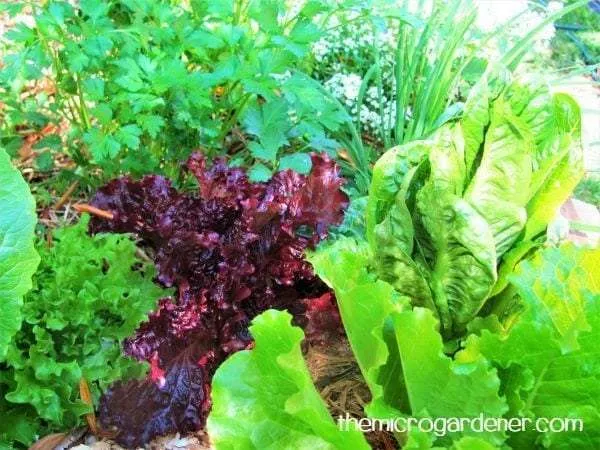
- Furniture – Are a table and chairs the focal point in your garden? Then add some colour to the table with a living arrangement. It can be a real drawcard for the eye. Choose fragrant flowers and herbs to engage the senses even further. Try herbs that you can use as a freshly picked garnish when eating outdoors like parsley, coriander and chives. They provide wonderful digestive enzymes too.

-
- White, Grey & Blue – these colours go with everything: e.g. blue/green leeks; sages that have blue flowers (most of their flowers and leaves are edible); culinary sage; alyssum (white); cauliflower; and some cabbages.
9. Beautiful gardens avoid clutter
This may be challenging if you have a really small space and want to grow a lot of plants! However, overcrowding will only make access difficult and the overall use of the space challenging. Try to balance hard surfaces with the plants you select and avoid using too many different materials.
Consider growing some plants indoors and spread them out to areas of the home where they suit the light conditions. Ferns for example love the humidity and lower light conditions in many bathrooms whereas outdoors they may take up too much valuable personal space that could be better used for other plants or furniture.
Use vertical spaces like walls, railings, containers and hanging baskets to free up floor space on a small deck or balcony.

10. Choose Variegated Foliage
In some circumstances where you may have reduced sunlight, you may not have many options to grow flowering plants. You can still add colour and structure by choosing plants carefully.
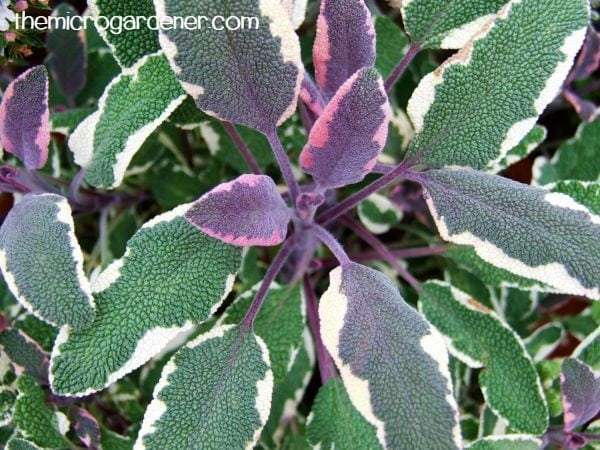
Even edibles like variegated sage with white, green and purple leaves are a stunning variety
Another option is to include variegated foliage that typically have one colour on the inside and a second colour around the edge of the foliage. Some ornamental varieties are Cordylines, Dracaenas, Mandevilla, Rhoeo and Sanseveria. Many striking varieties can also be grown indoors to enhance indoor beauty and improve our air quality.
“Gardening is the art that uses flowers and plants as paint, and the soil and sky as canvas.” – Elizabeth Murray
How have you added beauty to your garden?
